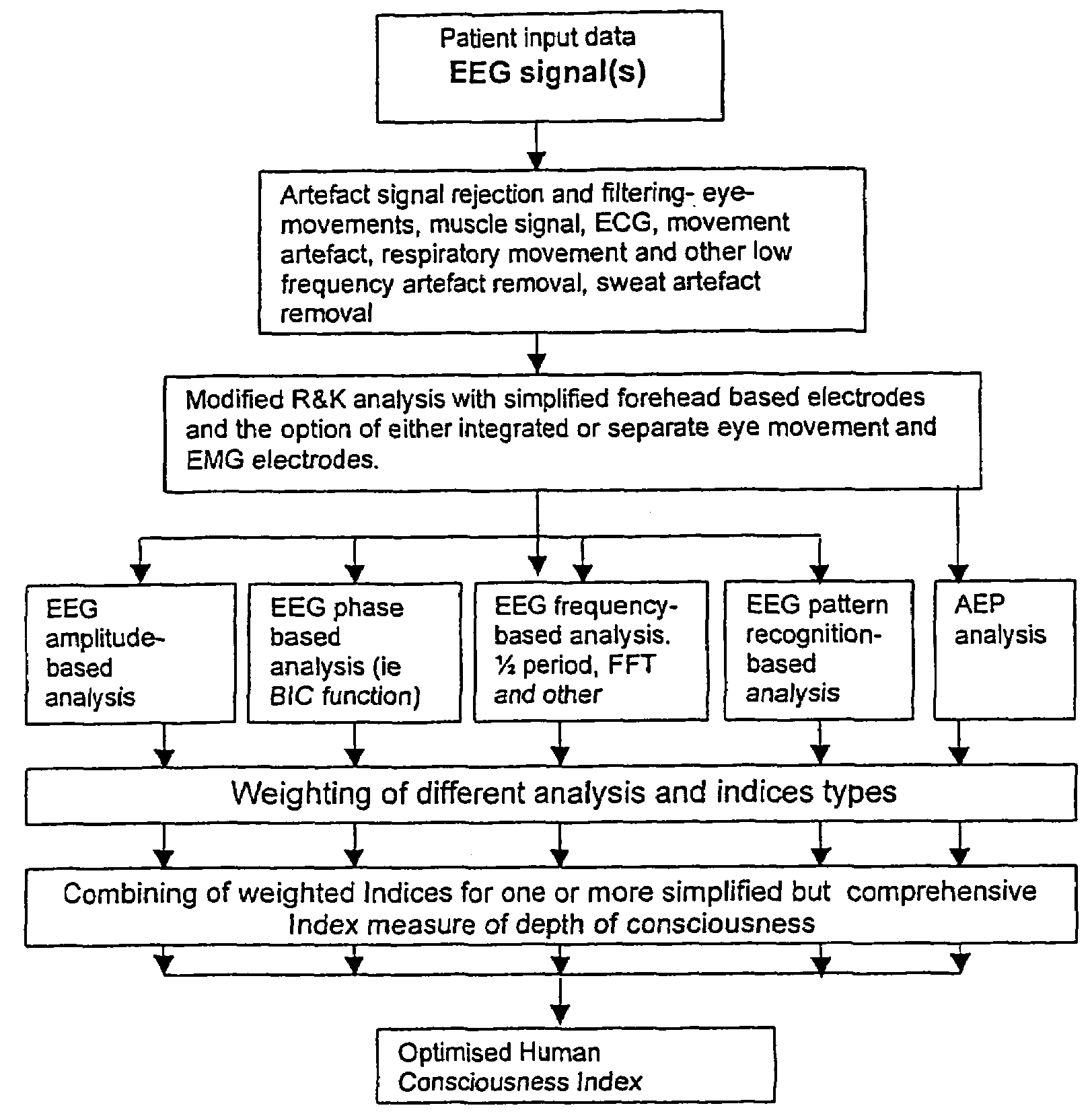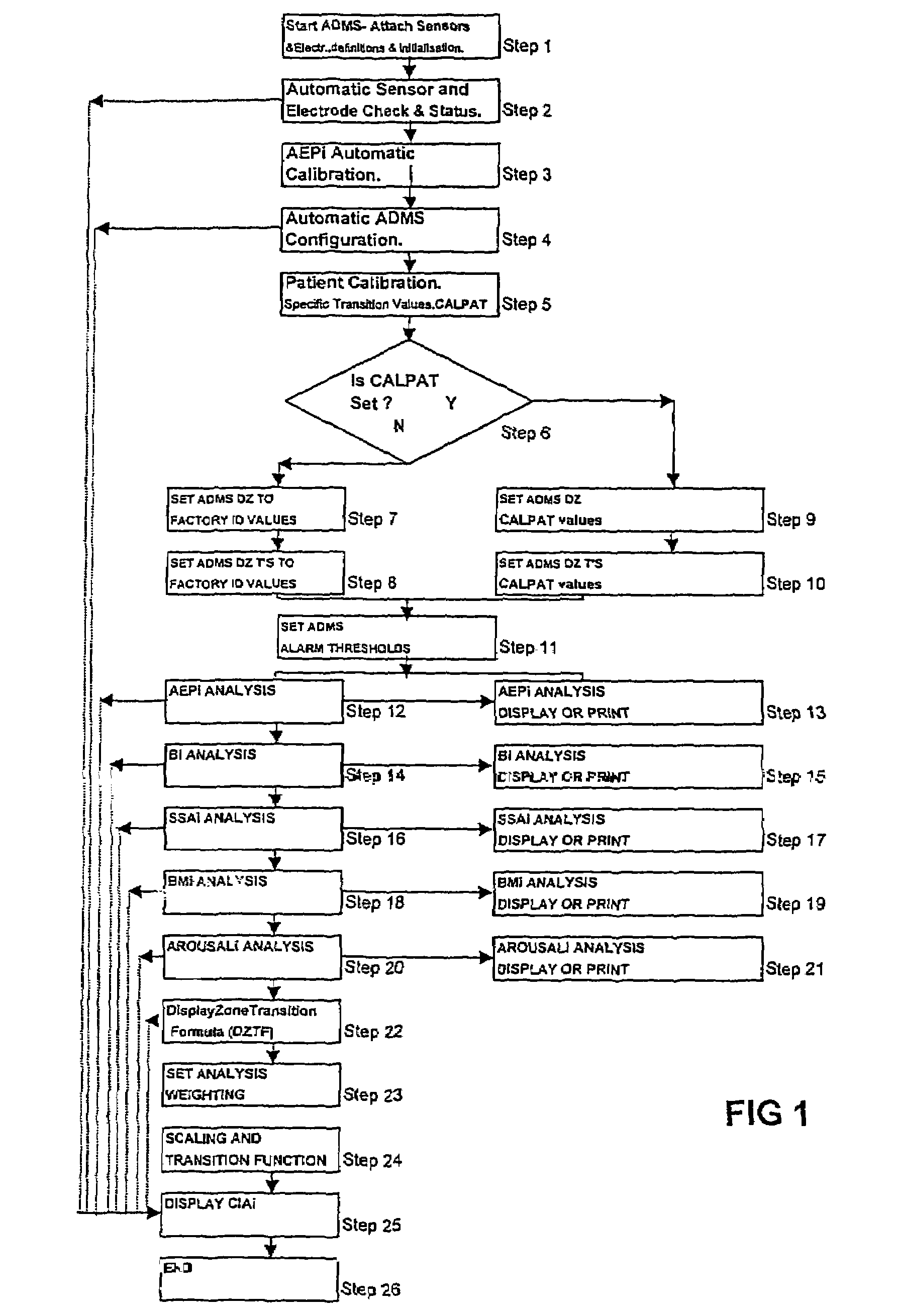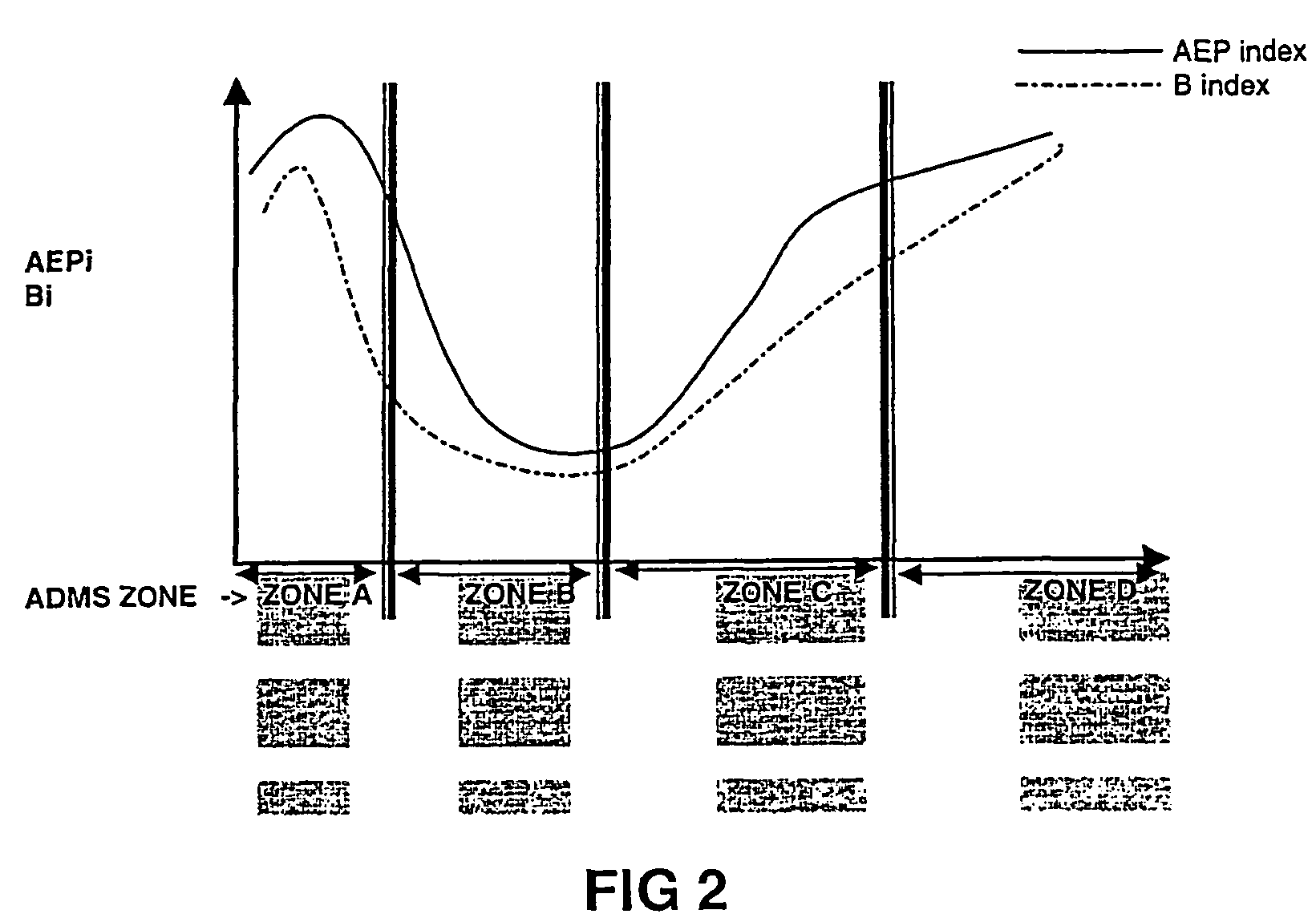However, a comprehensive or detailed understanding of how anaesthesia works is still unknown today.
The current state of the art provides an array of systems to monitor a patient whilst undergoing anaesthetic drug delivery, but none of these accommodate monitoring and validation of the range of sensory parameters satisfactory to monitor for “shut-down” or unconscious state of neural recall (including state of hypnosis, unconsciousness and sleep), auditory recall state (including Audio Evoked Potential and complex frequency and sensitivity state), muscle paralysis, movement and arousal state (including arousal and body movement analysis), visual recall state, (including eye opening and eye movement analysis state), anxiety and stress state (including temperature, blood-pressure, oxygen saturation-SA02, heart-rate variability, skin galvanometry resistance analysis).
However, the working of the brain's responses to anaesthetics and subsequent “shut-down” of the body's sensory systems still remains a mystery.
In other circumstances a subject could enter a hypnotic state where the driver of a car, for example, lapses into a type of “trance” and the state of vigilance and the subject's environment could become critical and highly dangerous.
The chances of being aware and experiencing pain are even lower but the consequences can be devastating.
However, the downside of the application of these muscle drugs is that a patient is paralysed so that conscious or unconscious movement is impossible.
In circumstances where a patient is awakening or is in a state of consciousness during a medical procedure, the patient is unable to move and defend him / herself or alert anyone of a potentially horrific experience that the patient may be encountering.
While positive messages during surgery may have desired consequences others can have undesirable results (98).
In particular it appears that the science and knowledge associated with details and the sequence of “shutting down” of consciousness and human sensory systems including sight, hearing, smell, consciousness and muscle activity or arousal necessary to avoid potential recall of a patient's experiences associated with anaesthesia, is still relatively young and inexperienced.
In some instances patient or subject specific data may substantially affect monitoring or analysis methods associated with the monitoring system.
However one problem with surface electrode connections is that the quality of the connection to the subject can deteriorate due to a number of conditions including patient sweat, movement or drying out of the connecting electrolyte solution between electrode and subject.
The problem of electrode quality may be more critical in applications such as those associated with intensive care and operating theatre environments, than is the case with depth of anaesthesia monitoring systems.
However one problem associated with depth of anaesthesia monitoring is that some patients awaken prematurely during a medical procedure and opening of the eyes can lead to distressing views and subsequent recall or nightmare occurrences.
A further problem exists where the patient may litigate in such instances, in which case an objective and accurate recording of the patient's state and amount of eye opening may be important.
However, even with improved analysis of EEG data as described above, another prior art limitation exists.
This limitation is related to the fact that while the combined frequency and phase analysis of EEG data may provide an improved method for monitoring a patient's state of consciousness, it has been found (4) that Audio Evoked Potential (AEP) provides a more informative measure of a subject's transition from unconsciousness to consciousness, while EEG based bi-spectrum analysis provides a more informative measure from consciousness to unconsciousness.
However, AEPi proved to offer more discriminatory power in the individual patient.
It is apparent that no one singular method for determining a subject's state of vigilance is appropriate.
A common problem with frequency-based analysis methods (be it sleep-wake or bicoherence / bispectrum / triple product) in analysing neurological data, is that the results of the aforementioned types of analyses can change significantly with seemingly stable physiological conditions.
Prior art systems (such as Aspect Monitoring) are limited as they are not as precise or responsive as an AEP, arousal or EEG activity based system for detecting transition and AEP responsiveness to transition but not as gradual a measure (as BIC) for predicting consciousness state.
However a limitation of this prior art method is that the gradual change of the bicoherence measure may, by nature of the type of the non-linear analysis prevent a clear or significant emphasis of the subject's transition state.
A disadvantage of this method is that the state of transition based on AEP analysis is relatively sudden due to the sudden response of the auditory nerve during the transition of a subject's state from unconsciousness to consciousness (30).
However the applicant is not aware of any prior art system or method that is able to provide an ideal solution.
Some of these limitations arise, for example, from the fact that it has been found that infants exhibit higher amplitude of EEG frequency bands such as deltawave than do more elderly patients.
It has also been found that in infants conventional methods of scoring sleep are not an accurate indication of the child's sleep physiology.
However one problem associated with surface electrode connections is that the quality of the connection to the patient can deteriorate as a result of a number of conditions including patient sweat, movement, or the drying out of the connecting electrolyte solution between electrode and patient.
In particular the problems of electrode quality may be particularly critical in applications such as those associated with intensive care and operating theatre environments, as is the case with depth of anaesthesia monitoring systems.
However in some instances patient specific data can substantially affect monitoring or analysis methods associated with the monitoring system.
However one problem associated with depth of anaesthesia monitoring is the fact that some patients awaken prematurely during a medical procedure and opening of the eyes can lead to distressing views and later recall or nightmare occurrences.
A further problem is the patient may litigate in such instances.
These finger attachment systems apply pressure to a patient's finger and can become uncomfortable after a period of attachment to the patient.
Whilst these wristband cuff blood pressure systems, are potentially less invasive than upper arm cuff type systems, it is apparent that measurement reliability of wrist systems is more vulnerable to sensitivity of positioning and difficulty in obtaining a consistent and reliable measurement.
Both cuff type systems are not used routinely for real-time and continuous blood pressure monitoring applications (such as depth of anaesthesia, respiratory disorder and sleep disorder monitoring) due to obvious discomfort and complexity and inconvenience of such measurement techniques.
 Login to View More
Login to View More  Login to View More
Login to View More 


